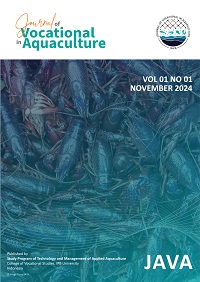The Effect of Different Live Feeds on the Growth Performance of Wild Betta Betta channoides Fry
Abstract
Wild betta fish Betta channoides is an endemic species from East Kalimantan, Indonesia. Currently, wild betta Betta channoides is classified as a species threatened with extinction due to a declining population, caused by environmental damage to its natural habitat. This damage is driven by the construction of the new capital city in East Kalimantan, deforestation for oil palm plantations, and overfishing to meet trade demands. To preserve the existence of Betta channoides, domestication efforts are necessary. Depok Ornamental Fish Cultivation Research Institute has been working on cultivating this species since 2019. However, one of the current challenges is the suboptimal growth of larvae due to the lack of knowledge of suitable life feeds for accelerating fish growth. The aim of this study is to enhance the growth of wild betta fish Betta channoides larvae by providing different types of life feeds. The method used was a completely randomized design (CRD) with four treatments and three replicates: Artemia sp. (K), bloodworms (CD), silk worms (CS), and water fleas (KA). Data were analyzed using SPSS with Duncan's test and the Kruskal-Wallis test. The results showed that feeding with silk worms yielded the optimum outcomes for absolute length growth 0.780 ± 0.020 cm, absolute weight growth 0.272 ± 0.005 g, and survival rate 93.33 ± 5.773%. The data indicated that silk worm treatment had a significant effect compared to the control, bloodworms, and water fleas. The study concluded that different feeds significantly affect growth performance and survival rates, with silk worms producing the highest results.











